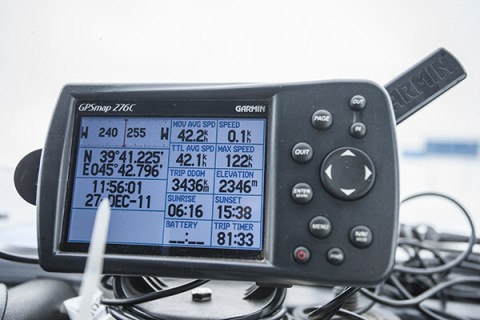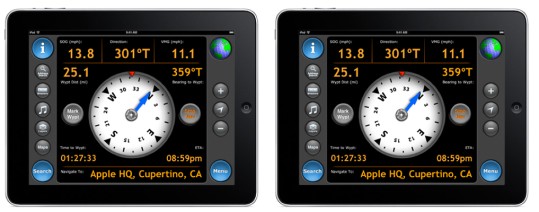
When I first started off roading, having a good GPS was not a common thing. Eventually, over the years, I started to understand what it was that they did and how, and found the best one to suit my needs: the legendary Garmin 279c. You can ask anyone whos ever been off tarmac and theyll almost certainly have one or know a friend who does. Its been indestructible so far, on the truck, in the rain, taking an impressive pounding on the KTM but still being as reliable as ever. Until now.

For safety reasons as well as comfort and accuracy, I decided to use a Panasonic Toughbook C19 on long runs, and compare it with the 279c. Using MapSource / Basecamp and Google Earth, I was able to not only see the tracks and altitude differences, but also get a real feel for the land, houses and actual birds-eye view of my surrounding. It felt like a breath of fresh air and suddenly, against all odds, the Garmin seemed old. Ironically, the antenna that we plugged into the Toughbook was a Garmin as well.
It was at this point I thought to myself: If I was wrong about this, what else was I wrong in the GPS department?
A friend of mine, part of the Kamikaze Off Road team, was kind enough to point out yet another loop hole in my Garmin myth. One that I never thought Id actually consider: the iPad. Since the device has become a household name, a few companies have attached the App market with navigation software. While most of them are exclusively designed to answer road needs, there are those that have ventured in the adventurer side of the customer segment. The one I found most suitable for this task was Motion X.
Now, the three competitors for our GPS comparison are the Garmin 276C, the Panasonic Toughbook with MapSource / Basecamp and the iPad with MotionX installed.
First relevant issue is battery life, because even the best navigation is useless with no juice. Assuming that you dont charge it, our studies showed that the king still stands: the Garmin 276C, with a medium lit screen and medium level of details may last up to 7 hours on a single charge when decent signal is present. When signal is scarce and the satellite search takes place every 30 minutes, the battery drains almost twice as fast.
A close second was the iPad. With its amazing battery life, the issue with this device is really the light level and whether you use the internet connection or have preloaded maps. When you see, under the 3G button, the text may drain your battery faster you better believe it.
The last of the bunch is the chunky Toughbook. Even on a new battery, which is a difficult find these days, you wont get more than a third of what either of the first two does.
Next, we tested map and antenna speed. On the dirt roads of Turkey and Georgia, the Garmin and Toughbook performed side by side. Without fail, every time the Garmin would lose signal, the laptop would keep going like it was nobodys business. Its true that the Garmin has the ability to get connected to an exterior antenna, but why? There seems to be no point in getting a good GPS if youre going to need another antenna for it anyway.
Close to the Russian border, on a recent expedition, we crossed a valley known for its metal filled mountains. We would encounter, every so often, patches of perfectly good road and sky with no signal whatsoever. Between the two, the Panasonics superior processor and laptop resources would almost always get us back on route faster and more accurately. Out comes the iPad to challenge the Toughbook supremacy.
In the mountains of Romania, which are known for their thick, ancient forests, both devices had trouble. With preloaded maps on both the iPad and the Toughbook, the results were comparable. The small tablets GPS accuracy was impressive. We expected it to get all confused and lost, knowing Apples ability to oversell their devices. It seemed that this time, it was a realistic presentation. In all honesty, MotionX performed spectacularly and surpassed the Panasonic.
The third criteria we assessed was reliability. Anyone who owns a 4WD and needs a GPS is certainly going places. Places with mud, water and dust. Loads and loads of dust. So how do the three devices stand here? Well, theres a reason why the Toughbook is called the way it is. With all the ports sealed, and more than an inch in thickness, you can literally drive over it and itll work just as usual. Ours has been down in mud, rained on, dropped countless times and is possibly the dustiest thing in the truck on occasions. Its reliability is unquestionable.
The Garmin 276C is a chart plotter by default. This means its used on boats, on water, in the rain, on a constant basis. Everything is sealed shut and water and dust cant get in. However, the power connection port has a rubber seal that will get worn out quite fast. Its meant to hide behind the swiveling antenna but the system isnt a brilliant one and itll tear the rubber off eventually.

Last, but not least, the iPad. By itself, the device isnt exactly expedition savvy. A drop will bend it, not to mention seating on it or rain. But, combined with an Otterbox Defende protection, Pelican or Kraken cases, itll do quite well. In all honesty, we didnt have the heart to test it out in rough conditions but Andy Campbell of Pushing the Limits vouched for it. When they camped at my place he worked on it and was well roughed up. Ten thousand miles on the road, flight and kayaking will do that to a case. He was very happy and recommended it.
The final aspect well be talking about is processing power and tech quality.
The Garmin has always had a reputation as the adventurers choice and for good reason. Its been around for ages and people still apreciate it. However, I wish it had at least a touchscreen, not to mention a more powerful processor and uprated internal antenna.
Better yet is the Panasonic. Comparable to the Garmin, the Toughbook is a dinosaur, albeit a reliable one. As a laptop its not much, but it comes through whenever and wherever you need it. The fact that you can cache about 2 Gb of map info from Google Earth and navigate them is, in my view, a brilliant thing to have at hand. I found it endlessly useful every single time. One thing that the child in me has always appreciated was the rotating screen, turning the CF19 into a pen tablet. It was a great feature 6 years ago and still is.
Undeniably, the most powerful device, with the best resources is the iPad. The newest technology and multi touch screen, combined with 3G, Wi-Fi and extended customization possibilities rank it top of our list.